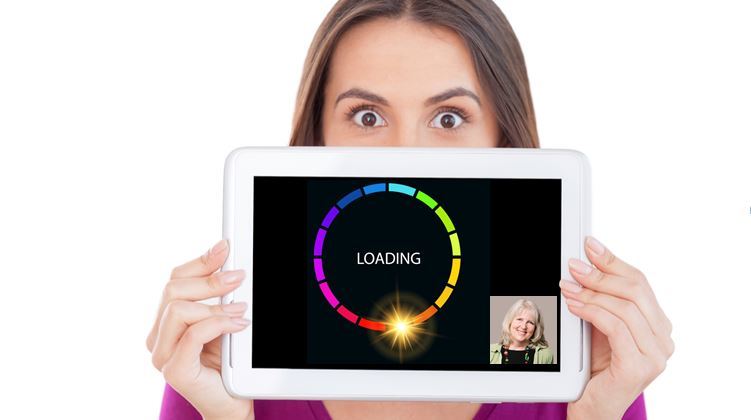
Meeting and communicating online is ripe for humour – especially if it’s from home. Perhaps you remember the BBC news interview that went viral last year when the interviewee’s children burst into his home office on live TV? In the UK we now have the comedy series ‘Hang Ups’, starring Stephan Mangan as the hapless online therapist working from home. The first episode starts with him hunting for his laptop charger a few minutes before a client call. Yep, been there too. And for anyone who has suffered a poorly managed video conference meeting, check out the hilarious video ‘A conference call in real life’. If you work online from home you will recognise these scenarios and share the joke.
So is it really possible to coach effectively online? In this article I’ll explain why I think online coaching not only works well but often can be more powerful than in-person coaching.
Working with virtual teams and individuals across the world has been a normal part of my working life for many years. When I qualified as a professional coach it was, then, a logical step for me to offer my coaching online. I’ve since come to realise that the idea of online coaching is new for many people and, for some, it is regarded as a poor substitute for meeting face to face.
In preparation for writing this post, I contacted a few of my past and current clients to ask them to complete a short (and less-than-scientific) survey. Obviously they are a small self-selected group of people who signed up to work this way; nevertheless, their comments give a snapshot of some of the things that clients value about online coaching, so I have quoted their words throughout.
Video or audio?
Advances in video-conferencing over the last couple of years have made it really easy for even for the most techno-phobic coaches and clients. Working online, clients can log in on their computer or tablet or they can phone in. When I first design our coaching alliance I usually give the client the option to work using video or audio only. Some people opt for audio and tell me that they find this aids introspection:
“Coaching by phone really worked well for me. It allowed me to focus on myself and the work I was doing, with fewer distractions.”
Sometimes I suggest we switch from video to audio for a part of a session: for example, during a guided visualisation. But the choice is always with the client. When the internet connection is poor, it is often necessary to drop the video but I rarely find this to be a problem. In the spirit of true coaching, we simply work with what we have. The trick is to not get flustered by the technology and to keep your focus on the person.
Some clients like to phone in because then they feel free to move around during the session. I even have one client who walks her dog. That’s not to say that coaching with video means you are rooted to your chair. I invite my clients to stand up, move around and use the space they are in – and I do the same my end.
Also for some clients, and this may be a generational thing, video is just what they are comfortable with:
“The video felt more personal.”
“For me, having video provides a level of connection and transparency that just audio doesn’t bring.”
Being ‘present’ online
The job of the coach in any context is to listen deeply, to pay full and absolute attention to the other person and to register the minute changes that signal an internal shift: the catch in the voice, the hand that rubs the temple, the sigh or the dropping shoulders. This is perfectly possible to do online or by phone but the coach needs to focus on tuning in and working in the present moment. When I am doing this, I almost feel like I am reaching through the screen, or along the wire, to connect. I experience the energy shifts, the intuitive moments and the shifting ‘temperature’ of the session in just the same way as I do if we are in the same room. My clients confirm this:
“You may think connection and trust with a coach can only occur in person, when actually there is an energetic exchange that transcends physical proximity which is pretty cool.”
“I was surprised by how powerful it was – I often felt emotional afterwards and had to spend some time processing what we’d discussed.”
“I found it pretty seamless to get a working relationship going with my coach and build the supportive and trusting environment needed.”
How is online better than in-person?
Coaching online offers a number of practical benefits:
“No travel therefore easy to plan into routine.”
“Coaching online can be done from the comfort and privacy of your own home and at a time negotiated suitable for both parties.”
“Being able to experience coaching online means I have access to an expert coach that I wouldn’t otherwise get access to in the country I am based.”
Such advantages mean coaches are able to extend access to wider sections of the population worldwide. It’s no longer a perk available just to the high fliers. I have coached people in remote locations who would otherwise be isolated and unable to benefit from coaching support. Making the most of different time zones, I have coached people early in the morning or later in the evening which means they choose the time that works for them. I’ve coached people with caring responsibilities who can’t leave the home and I’ve worked with women on maternity leave. The possibilities are endless.
In some cases, online coaching has outcome benefits that are not possible in-person. One of my clients found that using her own space for coaching made it a more powerful experience:
“It allowed me to be in my own space while being coached. And I could undertake exercises/tasks relating to my space, which I still draw on (e.g. the desk activity where I chose perfume, rubber….looking at the tree from my window, etc.) So I think it was more intense/powerful than going to a ‘neutral’ space.”
This same client also reports that, months after our coaching, she still draws on the work, prompted by these reminders and other structures that we put in place.
For the most part, I am separate from my clients’ communities, workplaces or general networks. This fact alone can help some people to drop the mask and to work in a very raw and real way. For me, I love the multicultural and diverse reach that online coaching allows me. I am building a portfolio of clients who are located across the world - Uzbekistan, the Lebanon, Australia, the US and Europe – and this enriches me and my life.
What could possibly go wrong?
“I did have to brief the family to leave me in peace. I just explained it was work.”
So how do you avoid the pitfalls that are the stuff of viral videos and comedy series? A few simple guidelines can help:
For the coach:
- Know the technology, but focus on the person not the tool.
- Bring all your coaching skills to the call and amplify them – tune in; listen attentively; use your intuition; be present; use silence, embodiment and the geography of the space.
- If things go wrong, hold it lightly and troubleshoot. Have a back-up plan if connection is poor.
- Make your own space comfortable for yourself and not too distracting for your client.
For the client:
- Choose a time and a place where you can talk confidentially and without interruption.
- Close all other applications and notifications on your computer and turn off your phone.
- Check your internet and microphone settings before you start.
- Allow yourself a short interval before the session to focus and after the session to process the work you have done.
If you are curious about online coaching and want to give it a go, I’d love to show you how it works. Just book yourself in for a free call (use the Let's Chat button at the top of the screen) and I'll see you in my coaching cabin!




